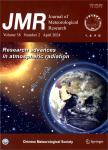An Efficient Method on Deriving Topographic Index from DEM for Land Surface Hydrological Model Simulations
An Effcient Method on Deriving Topographic Index from DEM for Land Surface Hydrological Model Simulations作者机构:Key Laboratory of Regional Climate-Environment Research for Temperate East AsiaInstitute of Atmospheric PhysicsChinese Academy of Sciences College of Resource and EnvironmentSichuan Agricultural University Graduate School of the Chinese Academy of Sciences Linyi Bureau of Meteorology
出 版 物:《Acta meteorologica Sinica》 (ACTA METEOROLOGICA SINICA)
年 卷 期:2009年第23卷第5期
页 面:609-616页
核心收录:
学科分类:0707[理学-海洋科学] 08[工学] 081501[工学-水文学及水资源] 0815[工学-水利工程] 0706[理学-大气科学] 0816[工学-测绘科学与技术] 0824[工学-船舶与海洋工程] 0825[工学-航空宇航科学与技术]
基 金:Supported by the National Key Development Program for Basic Sciences of China under Grant No.2006CB400502 the 100 Young Talent Project of Chinese Academy of Sciences under Grant No.8-057493 the Special Meteorology Project of China Meteorological Administration under Grant No.GYHY200706001
主 题:TOPMODEL topographic index (TI) digital elevation model (DEM) pits fiat areas
摘 要:As a kernel parameter of the TOPMODEL-concept-based land surface model (LSM), topographic in- dex (TI) is commonly derived from high resolution digital elevation model (DEM). Various approaches to compute TI by using different algorithms have been developed in previous literature. However, fiat areas and pits in DEMs of real watershed sometimes impose an arbitrary and spatially constant drainage density which may cause conventional retrieval methods to be very computer-intensive, especially for regional or global climate simulations where rugged mountainous areas are mixed with fiat terrains in the DEM. In this paper, we propose a new approach to overcome this shortcoming by introducing a quantile classification to sort the DEM into eight categories at first and then using a fast and simple algorithm to process the fiat areas, fill up pits in the DEM, and make it undulating. Thereafter, the algorithm can be directly applied to assigning flow directions of each cell of the processed DEM rather than taking the complicated approach of Jenson and Domingue. This approach dramatically promotes the computing efficiency with a much easier and faster processing. In addition, the effects of different TI computing approaches on the TOPMODEL-concept-based hydrological simulations are investigated based on experimental simulations over a small-scale watershed gauged by the Yonshuijie hydrological station and a large-scale watershed controlled by the Hanzhong hydrological station, respectively. The results show that the new approach is 13 times faster than the conventional one in TI retrieving, and no evident differences are found in rainfall- runoff simulations when using different algorithms in TI computations. These suggest that the proposed new approach for TI computation can be taken as an alternative and used in the TOPMODEL-concept- based hydrological simulations owning to its simplicity and high efficiency, especially for relevant regional and global studies.



